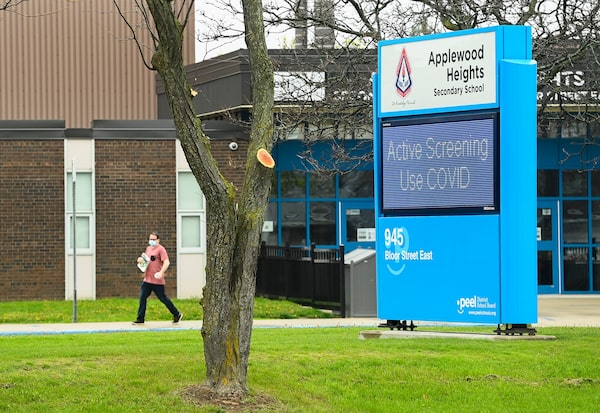
The human cost of COVID-19 on education has been severe. But it has created a unique opportunity for re-evaluation and reform within the education system.Nathan Denette/The Canadian Press
Rachel Strathdee is a Grade 12 student at Abbey Park High School in Oakville, Ont. This essay was the winner in the Federation of Canadian Secondary Students’ Demystify Tribune Student Voice Essay Contest.
Over the past two years, adaptation to the COVID-19 pandemic has defined many aspects of our lives. Thousands were hospitalized, lockdowns shuttered restaurants and retailers, and work moved from cubicles and boardrooms to home offices and kitchen tables. Among a myriad of consequences of the pandemic, one in particular has shaped the lives of youth: the shift to remote learning.
March, 2020: In a matter of days, schools were shut down, and hundreds of thousands of students across the country were forced to adapt to a scenario for which they were entirely unprepared. Virtual classes meant tests, evaluations and assignments, but with a lack of interpersonal connection, face-to-face interaction and academic support, aspects of education that often form an integral part of a student’s school experience.
While some students thrived in this new environment, others barely survived. Those with a propensity for self-directed, independent work were able to flourish, but others struggled, and severely. Many grappled with mental-health issues, social deprivation and isolation, and finding meaning in their educational experience. The coronavirus also served to exacerbate existing educational disparities; students disadvantaged by factors such as learning disabilities, limited digital literacy and socioeconomic status faced unique challenges.
In any case, the switch to remote learning made one thing abundantly clear: Education is far from a “one size fits all” scenario, and schools lack the infrastructure to effectively, or even adequately, cater to the diverse needs of their student population.
Undeniably, the human cost of COVID on education has been severe. However, it has created a unique opportunity for re-evaluation and reform within the education system. Virtual learning highlighted the inequitable nature of the existing system, raising valuable questions and prompting a widespread realization about the reality that Canadian youth faces – the reality of an education system at odds with them, a system irreconcilable with their needs, their lives and the challenges they face.
This disconnect is not solely the product of the coronavirus pandemic – underlying issues were simply illuminated by remote learning and its consequences. It is actually a result of a much deeper, more serious issue, one rooted in the fundamental purpose of the education system: Schools are meant to create workers.
The historical basis for the contemporary schooling system stems not from the needs of students, but from the needs of industry and the economy. The Industrial Revolution led to a considerable uptick in demand for workers and labourers, and to accommodate the proliferation of industrialization, youth were placed in “factory model schools,” institutions that were meant to instill in them the skills needed to thrive in subordinate roles. These schools were meant to create hard-working, compliant labourers, and as industrialization became more widespread, this method of education caught on, creating the basis for the present system.
This framework for our education system was developed in an entirely different time and has faced limited scrutiny throughout decades of use. The enduring legacy of these “factory schools” continues to affect youth today, as they are taught based on an antiquated model of education, one antithetical to passion, meaningful learning, self-actualization and personal fulfilment.
The pandemic and the switch to remote learning have highlighted the drastic discrepancy between the current education system and the needs of students, and have illustrated the need for extensive and rigorous reform. No two students are the same – yet, within each province and territory, youth are educated in the exact same way. We learn from the same curriculum, undergo the same evaluations and are assessed based on the same criteria. Students deserve an educational system that works in their own best interests, one that truly seeks to support and improve them.
Education with a greater focus on individual needs will empower students. It will allow youth to learn more effectively and develop their passions, and will stimulate a desire for self-improvement. This sort of educational reform will also serve to combat the mental-health issues and disillusionment prevalent among contemporary youth.
It’s clear that the current educational system is not working for students, and as society continues to develop and the education system remains in a state of stagnancy, the discrepancy between students and the system that dominates their lives will only grow. The future of education defines the future of our youth and, by extension, the future of our country.
As the pandemic has sparked change in health care and employment, why can’t it do the same in the sphere of education? Many Canadian students lack passion and struggle with engagement in learning, but educational reform in the wake of the COVID-19 pandemic has the potential to change this antiquated, damaging system. We have learned many lessons from the pandemic and from remote learning, and we now have the opportunity to apply this, which will allow us to create a more inclusive, equitable system of education that supports all students.
Keep your Opinions sharp and informed. Get the Opinion newsletter. Sign up today.